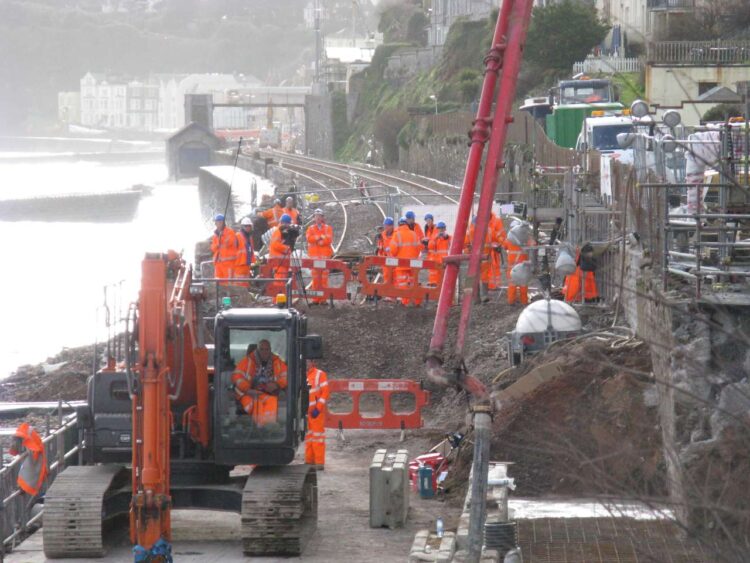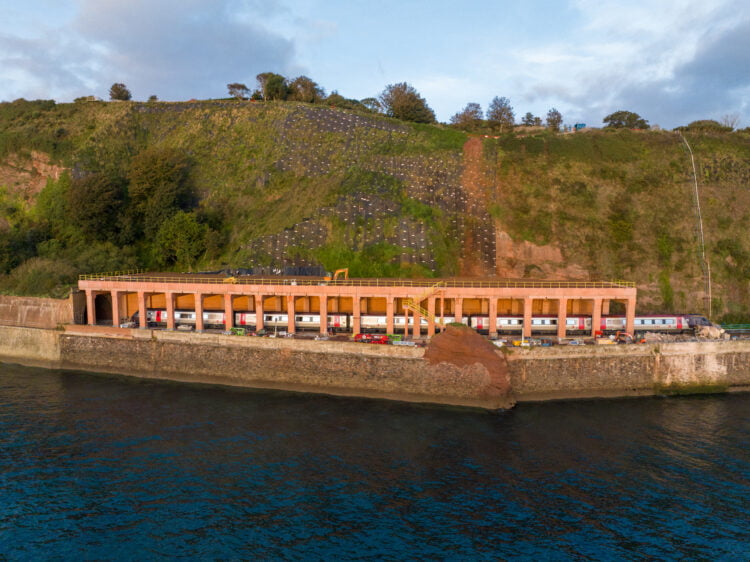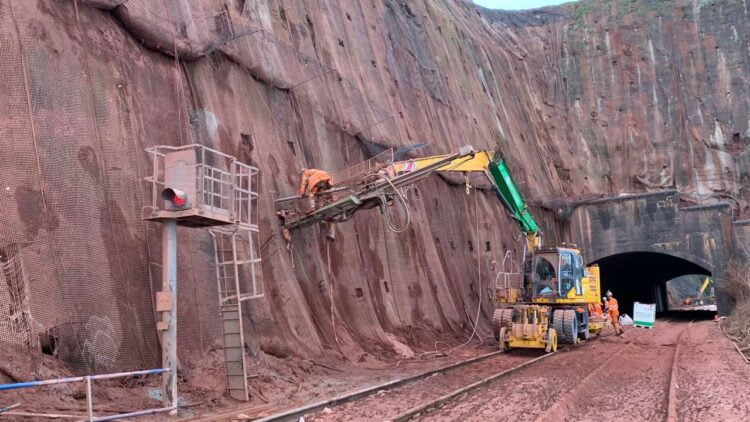A decade on from the devastating storm that cut off the only railway line to southwest England for eight weeks, resilience measures built since then are proving effective.
The storm battered the south Devon coast over 4 and 5 February 2014, causing significant damage to the railway track at Dawlish, leaving thousands of local residents without power and forcing some people to abandon their homes.
Communities in fifty towns and cities across the south-west peninsula were cut off from the rest of the UK.

Three hundred engineers worked night and day for eight weeks in what then Prime Minister David Cameron called “a Herculean effort” to rebuild the track and return the railway to service. The repair cost £35m.
In the ten years since the storm, Network Rail has spent £165 million of funding from the Department for Transport on improvements.
In response to the storm, the South West Rail Resilience Programme came into being, and carried out detailed studies to establish how to make the iconic stretch of railway between Dawlish and Teignmouth more able to withstand rising sea levels and extreme weather.
In the last five years, the programme has delivered:
- a sea wall at Dawlish that is taller and stronger than its predecessors and stretches eight hundred metres between Boat Cove and Coastguard’s breakwater, and which features a new high-level promenade, link bridge and curved design to deflect waves back to the sea;
- a new footbridge with lifts at Dawlish station, which gives it step-free accessibility for the first time;
- a 109-metre rockfall shelter at the northern end of Parson’s Tunnel to protect the railway from the cliffs above, built from 185 pre-cast concrete units, and coloured red to match the local sandstone;
Work has also started on installing 19,700 square metres of netting, secured by more than six thousand soil nails, to improve the resilience of the cliff between Dawlish and Holcombe. Network Rail expects to complete this work later this year.

A further five million pounds was allocated to develop plans for the fifth and final phase of the South West Rail Resilience Programme, addressing the stretch of railway between Parson’s Tunnel to Teignmouth.
This has resulted in a proposal to install cliff drainage and resilience measures without moving the tracks away from the cliffs. Network Rail has submitted an outline business case asking for funding to carry out drainage trials, further investigations and design work for this section of the railway, which the DfT is currently reviewing.
The government has pledged to deliver this fifth and final phase of the South West Rail Resilience Programme as set out in its Network North strategy.
Network Rail’s capital delivery director Stuart Calvert said: “The South West Rail Resilience Programme is a really significant piece of work – not just for Network Rail but for the entire South West peninsula which relies on this vital artery to support communities, tourism and economic growth.
“Since the unforgettable storm of 2014, this stretch of railway has undergone an incredible transformation which is testament to the hard work and dedication of our team of engineers and contractors BAM Nuttall and Morgan Sindall.
“The new sea wall at Dawlish is performing as the design intended – returning the waves to the sea and allowing the railway to recover much more quickly from storms, while the rockfall shelter is preventing material from the cliffs reaching the tracks.
“Our resilience work that is ongoing and that which is yet to come will better protect this key railway route from rising sea levels and extreme weather for generations to come.”

Andrea Davis, Devon County Council cabinet member for climate change, environment and transport , said: “The terrible storm ten years ago is still a sharp memory for many. Since then, the partnership working between Department for Transport, Network Rail, Devon County Council and Peninsula Transport has never wavered in the joint goal of a resilient railway in the South West.
“The political will to make this happen has never faltered, Anne-Marie Morris in particular has and continues to support and lobby for us. There is still more to do but the incredible new infrastructure is there for all to see and is testament to what can be achieved when all agencies work together on a shared ambition.”
Rail Minister Huw Merriman said: “A decade ago, the Dawlish storm battered south Devon, devasting its coastline and severing the south west from the rest of the country for eight weeks.
“Thanks to more than £165 million of Government funding to restore and protect this vital stretch of railway, its future is now secured. This will provide residents with peace of mind the line is better protected, no matter the weather.
“The South West Rail Resilience Programme demonstrates we are delivering our promises to invest in vital infrastructure to futureproof the network and improve transport connections across the country.”
Anne Marie Morris, MP for Newton Abbot:, said: “Ten years since the storm that brought down the sea wall at Dawlish, and we have been on an incredible journey since then!
“The South West Rail Resilience Programme is an incredible feat of engineering. Thank you to Network Rail, our very patient community and the many other unsung supporters of this vital project. We now just have the final phase to complete, which will be the most challenging part of the resilience programme – addressing the challenges of the cliffs at Teignmouth.
“The Government has committed to deliver this fifth and final phase to ensure that the peninsulas most important line is truly resilient. I will be working with Network Rail to ensure that the Government keeps good on the commitment made ten years ago.”






Responses
The inland bypass is still desperately needed, if it won’t be wave damage it will be cliff erosion both of which will seriously disrupt operations for a considerably time.